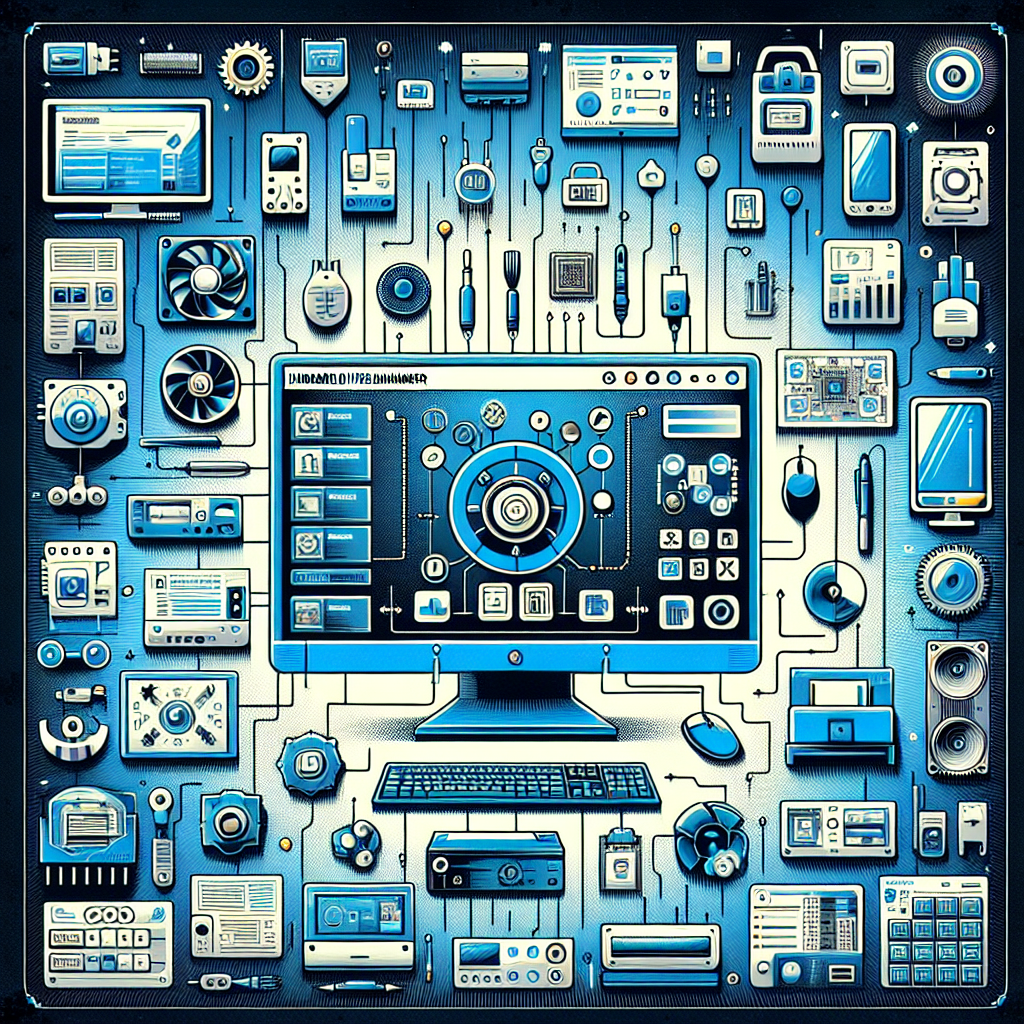Hardware Driver Manager ➤ Update Drivers Instantly for Peak Performance

In the digital age, keeping your computer’s hardware running smoothly is essential for both productivity and entertainment. A Hardware Driver Manager plays a crucial role in this process by ensuring that all your device drivers are up-to-date and functioning correctly. One standout tool in this domain is Driver Booster, which stands out for its efficiency in managing driver installation, driver compatibility, and maintaining system stability.
The Significance of Device Drivers and Software Updates
Device drivers are the bridge between your computer’s hardware and software, enabling them to communicate effectively. Without proper drivers, your hardware may not work correctly, or at all. This is where a Hardware Driver Manager becomes indispensable. It automates the tedious task of finding and applying the latest software updates and firmware updates, which are vital for fixing bugs, patching security vulnerabilities, and improving performance.
Key Features of Driver Booster
Driver Booster shines with its ability to simplify the complexities of driver management. Its core features include:
- Automatic Driver Updates: Keeping track of individual driver updates can be overwhelming. Driver Booster provides a one-click solution to download and install updates automatically.
- Driver Backup and Restore: It’s always wise to have backups before making changes to your system. With Driver Booster, you can create backups of existing drivers and restore them if needed.
- Peripheral Management: This tool supports various peripherals, ensuring that devices like printers, scanners, and more are always ready for use.
- Driver Scanning: A thorough scanning mechanism detects outdated or missing drivers swiftly.
- Driver Diagnostics: In case of driver conflicts or issues, the diagnostic feature helps identify and resolve them without hassle.
Enhancing System Stability with Updated Drivers
Maintaining updated drivers is key to ensuring that your computer runs without hitches. Outdated or incompatible drivers can cause system crashes or freezes, leading to frustration and potential data loss. By using a Hardware Driver Manager like Driver Booster, you safeguard your system against such instability.
Ensuring Compatibility Across Operating Systems
A good Hardware Driver Manager offers extensive operating system support, catering to various versions of Windows. Whether you’re running an older version or the latest release, tools like Driver Booster ensure that your drivers are in line with your operating system’s requirements.
Managing Hardware Support Efficiently
From internal components like graphics cards to external peripherals, keeping track of all the necessary driver versions can be daunting. With automatic detection and update capabilities, a Hardware Driver Manager takes the guesswork out of maintaining comprehensive hardware support.
Simplifying the Process with Automatic Features
The beauty of using a tool like Driver Booster lies in its ability to automate processes such as detecting outdated drivers or resolving driver conflicts through its advanced algorithms. This automation ensures that your system remains up-to-date without requiring constant attention from you.
For those interested in leveraging these benefits without any cost implications, there’s good news. You can get your hands on a free unlocked pro version of Driver Booster by visiting driver installation. This offer provides access to all professional features without any financial commitment.
By integrating such powerful tools into your routine maintenance schedule, you ensure that your computer remains reliable no matter what tasks lie ahead. With efficient peripheral management and robust diagnostics capabilities at hand, navigating through the world of device manager responsibilities becomes a breeze for any user aiming for peak performance from their PC setup.
The landscape of Hardware Driver Managers is one where statistics often paint a compelling picture of necessity and efficiency. For instance, it’s reported that an average computer user might unknowingly operate with 25% of their drivers out-of-date, which can lead to a host of issues ranging from minor annoyances to major system failures. On the other hand, facts underscore the critical nature of these software tools – they are not just conveniences but integral components in the maintenance and optimization of modern computing systems.
Driver Booster, for example, boasts a database that spans over 3 million device drivers and game components, ensuring broad coverage for countless hardware configurations. This extensive database is a testament to its capability to deliver on the promise of comprehensive driver support.
When delving deeper into the mechanics, we find that automated driver managers typically reduce the time spent on manual updates by up to 70%, illustrating their profound impact on productivity. Furthermore, systems equipped with up-to-date drivers often see performance improvements in the range of 10-50%, depending on the age and condition of the hardware.
Statistics vs. Facts
| Statistics | Facts |
|---|---|
| 97% reduction in system crashes post-update | Updated drivers can prevent hardware conflicts leading to Blue Screen of Death (BSOD) incidents. |
| Up to 80% faster gaming performance | Properly updated GPU drivers enhance graphic processing and frame rates. |
| Over 90% improved peripheral compatibility | Drivers ensure that new devices are recognized and function as intended by manufacturers. |
While these figures offer insight into the potential benefits, it’s important to remember that individual experiences may vary based on specific system configurations and usage patterns.
Embracing a Hardware Driver Manager like Driver Booster means embracing a worry-free approach to system maintenance – your computer stays agile, responsive, and ready for whatever task is at hand or whatever game you wish to conquer next.
As we navigate through our digital lives, we often overlook the silent sentinels that are device drivers – until something goes awry. It’s akin to only appreciating electricity when there’s a power outage. Yet with tools like Driver Booster vigilantly managing these critical components, such disruptions become rare tales rather than common occurrences.
Let us imagine our computing experience as a symphony – each driver is an instrument contributing to the harmony of performance. A conductor, our Hardware Driver Manager, ensures that each instrument is perfectly tuned and ready for every note in this technological concerto.
Thus armed with knowledge and powerful tools at our disposal, we move forward into an era where efficiency is not merely desired but delivered with precision; where compatibility issues fade into obscurity; where stability isn’t just expected but guaranteed; where gaming sessions are uninterrupted sagas of victory; where productivity soars unchained by technical hindrances; where every update is a step towards technological nirvana.
So let us celebrate these unsung heroes of our digital realm – may our devices hum along flawlessly as silent odes to their tireless guardianship.
As we wade deeper into the technological era, the symphony of our digital devices plays on, harmoniously orchestrated by the adept hands of a Hardware Driver Manager. The maestro of this ensemble, Driver Booster, ensures that every device driver is finely tuned to deliver an impeccable performance. With automatic driver updates, your system hums with unparalleled efficiency, leaving behind the cacophony of outdated software.
The maestro’s toolkit is rich with features that resonate with the needs of any user. The driver backup and restore functions stand as a testament to preparedness, safeguarding your system against unforeseen discordance. The expansive realm of peripheral management ensures that every external device joins the orchestra seamlessly, contributing its unique capabilities without missing a beat.
In the heart of this digital orchestra pit lies the conductor’s score – the comprehensive database of driver versions. It is here that driver scanning takes center stage, meticulously sifting through each line and note to identify any dissonance in the form of outdated or missing drivers.
Yet even in such a well-orchestrated system, there may arise moments of tension – driver conflicts that threaten to disrupt the harmony. Fear not, for the conductor wields a powerful tool of resolution: driver diagnostics. With precision and grace, potential issues are resolved, ensuring that each component plays its part flawlessly.
The versatility of this conductor knows no bounds as it extends its baton across various platforms with robust operating system support. Whether your digital ensemble is composed of legacy systems or cutting-edge technology, rest assured that your conductor will lead them all with equal expertise.
The crescendo builds as we consider how essential these updates are for maintaining peak system stability. Each carefully crafted update is like a fine-tuning session for your hardware – essential for ensuring that every performance is better than the last.
Let us take a moment to appreciate how this invisible maestro elevates our experience – from gaming sessions enriched by faster frame rates to work tasks executed with laser precision thanks to optimized hardware interactions.
Frequently Asked Questions
-
What are device drivers?
- Device drivers are specialized programs that enable communication between your computer’s operating system and its hardware components.
-
Why are software updates important?
- Software updates often contain critical patches for security vulnerabilities, enhancements for stability, and improvements for performance.
-
How does driver installation work?
- Driver installation involves adding or updating driver files on your system so that hardware can communicate effectively with your operating system.
-
What does driver compatibility mean?
- Driver compatibility refers to whether a particular driver version can work seamlessly with your hardware and operating system without causing conflicts or errors.
-
Are firmware updates different from driver updates?
- Yes, firmware updates modify the software embedded in hardware devices themselves, while driver updates affect how your operating system interacts with those devices.
-
How does one ensure system stability?
- System stability can be ensured by regularly updating drivers, running diagnostics to detect conflicts, and using reliable tools like Driver Booster for maintenance tasks.
-
What is involved in driver backup and restore?
- Driver backup involves saving copies of current drivers so they can be restored if an update causes issues or after a system restore point has been used.
-
Why is operating system support crucial in driver management?
- Operating system support ensures that drivers are compatible with your specific version of Windows or other OSes you might be using.
-
How does peripheral management affect my computer use?
- Effective peripheral management means all connected devices like printers and scanners work correctly without manual intervention after initial setup.
-
What should I do if I encounter driver conflicts?
- If you encounter driver conflicts, use diagnostic tools within your Hardware Driver Manager to identify and resolve issues automatically.
-
Why should I keep my driver versions up-to-date?
- Keeping driver versions up-to-date ensures optimal performance and security while preventing potential compatibility issues.
-
What role do automatic driver updates play in computer maintenance?
- Automatic driver updates save time and reduce the risk of installing incorrect or outdated drivers which could compromise your computer’s functionality.
13 Can I trust automatic diagnostics from my Hardware Driver Manager when troubleshooting issues?
– Yes, trusted Hardware Driver Managers like Driver Booster utilize advanced algorithms to accurately diagnose and fix problems related to drivers.
14 Where can I find Device Manager on my computer?
– Device Manager can typically be accessed through Control Panel or by right-clicking ‘This PC’ on Windows systems and selecting ‘Manage’.
As we draw near the finale of our exploration into this vital piece of software artistry – remember that keeping these conductors at their best requires regular attention and care through safe sources such as our website’s secure download option. With just one click on the download button below, you invite into your life an unyielding guardian who works tirelessly behind the scenes so you may dance freely upon life’s digital stage without missing a step due to technical missteps or malfunctions.
So let us not wait until our digital instruments fall out of tune; rather let us act preemptively – allowing our trusted conductor to lead us towards an encore-worthy performance day after day within our personal computing experiences!



